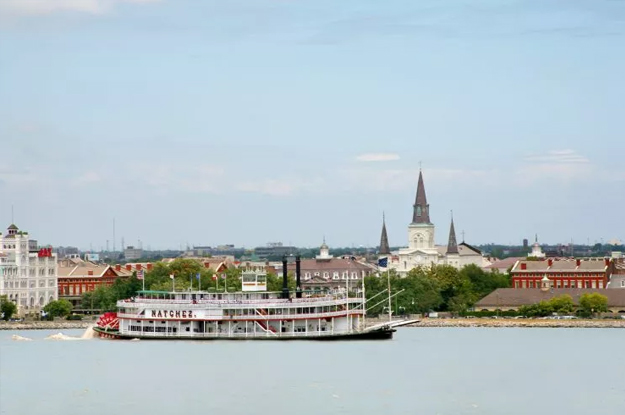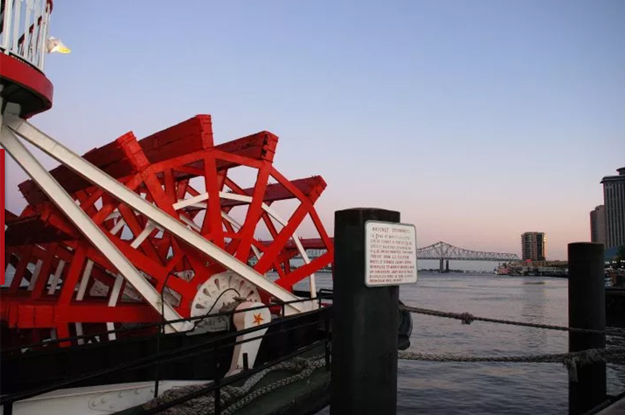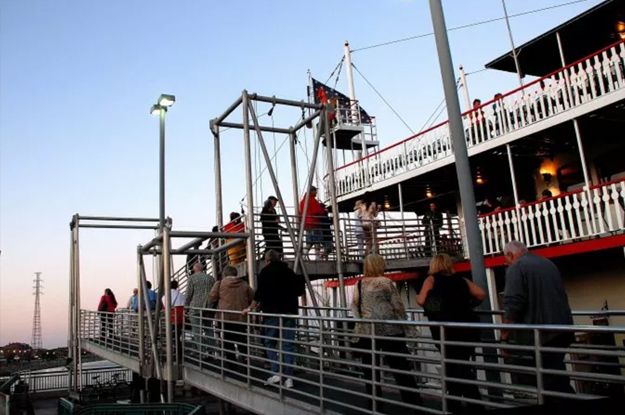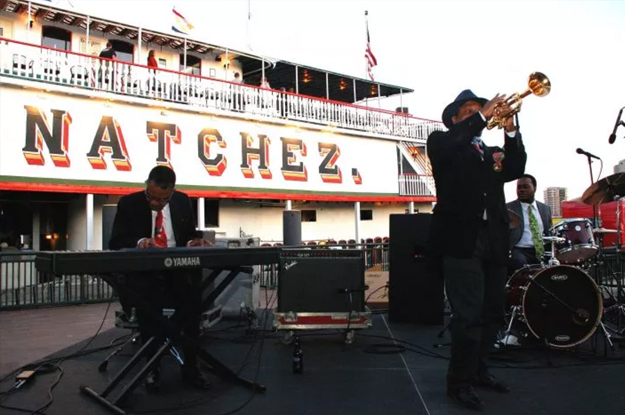
Mention the mighty Mississippi River and two things come to mind – Mark Twain’s Adventures of Huckleberry Finn and paddlewheel riverboats. Mark Twain’s descriptions of the river and the life around it transport us imaginatively. The rhythmic splashing sound of the giant paddlewheel as the steamboat makes its way around a bend in the most powerful river in the country evokes a romanticized view of America before cars, trains, and airplanes.
Meandering and timeless, the Mississippi is one of the world’s great rivers. Long before the introduction of steam-powered boats in the late 1700s and early 1800s, travel along the river between small towns and outposts, and downriver to New Orleans at its mouth, was by shallow draft, pole-powered riverboats. Going downstream was easy; the current did the work. Polling upstream was a challenge.
Travel and trade along the Mississippi became possible with the invention of the steamboat. The building of the first American steamboat, unsuccessfully by John Fitch in 1787, and successfully in 1807 by Robert Fuller, led to expanded trade, the growth of cities and the expansion of the United States to the west. Throughout the 1800s and 1900s, riverboats propelled by steam engines transported people and goods to and from towns along the Mississippi, creating important the trading cities of St. Louis, Memphis and New Orleans.
By definition, any boat that is powered by steam is a steamboat. Most steamboats built in the 19th and 20th centuries were propelled by paddle wheels powered by steam. Riverboats with paddle wheels on the sides were side wheelers; those with paddle wheels on the stern were sternwheelers. While our image of a paddle wheel steamboat is of beautifully appointed Victorian-era, multi-deck vessels called showboats, the floating entertainment centers of the Gilded Age, the majority of steamboats plying the river were utilitarian. These workhorses came in many sizes and shapes. Packet boats carried crops and people; towboats pushed barges up and down rivers; ferries carried people; fuelers re-supplied other steamboats; snag boats kept the river navigable by clearing debris.

By the early 1900s, the westward growth of the country and the American industrial revolution created railroads. Their speed and reach led to the gradual end of steamboats along the Mississippi River. The nostalgia for them remains in the form of a handful of beautiful replica or restored paddle wheelers used for sightseeing and river cruises.
Two of the most popular replica paddlewheel riverboats are in New Orleans. Steamboat Natchez is steam powered; Creole Queen Paddle wheeler is diesel-electric powered. When visiting New Orleans, slow down the pace on a languid cruise along the Mississippi River on one of them. As the powerful paddles begin their muffled, mesmerizing water sound, the world is transformed by the rhythm of the timeless river and unique skyline sights. Along the shore of the river that has seen comings and goings of people from all over the globe, ancient buildings of Vieux Carré and distinctive landmarks come into view. Cooling breezes soothe and muffled sounds of jazz waft over the water. It’s magical.
Trusted Tours & Attractions offers several options at discounted prices on both paddlewheel riverboats. Each has the gracious ambiance of another century with modern amenities. They offer similar experiences which include:
- Live narration
- Amazing skyline and port views
- Live jazz music
- Lunch or dinner buffet options and cash bars
Steamboat Natchez
The ninth steamer to bear the name. Built in 1975, she is a replica of a 19th-century steam-driven paddle wheeler. Her legacy comes from a long line of steamboat race winners including the most famous, Natchez VI, whose triumph over Robert E. Lee is legendary. All cruises are two hours plus one hour boarding time during which guests are welcomed aboard by a calliope concert.
- Steamboat Natchez Harbor Cruise – Choice of morning or afternoon cruise around the harbor. No meal. Good for visitors who enjoy sightseeing from a unique perspective without the distraction dining.
- Steamboat Natchez Creole Lunch Cruise – Choice of morning or afternoon harbor cruise with a Creole buffet lunch. It’s a great way to enjoy a relaxing outing on the Grand river with wonderful views and a tasty New Orleans lunch.
- Steamboat Natchez Dinner Cruise – A romantic evening cruise up the Mississippi River with a lavish Creole dinner buffet and the cash bar. Great for couples and anyone who enjoys a unique evening cruising under the stars along the alluring Mississippi.

Creole Queen Paddlewheeler
Built in 1993, she has huge 24-foot diameter paddlewheel powered by a fuel-efficient diesel-electric system. Layers of promenade decks and three dining rooms accommodate 1000 people. Victorian-style interiors, soft lighting, and three dining rooms create an elegant atmosphere. All of her cruises are 2 hours plus an hour of boarding time.
- Creole Queen Chalmette Battlefield Cruise – Harbor tour with the added bonus of disembarking at the Jean Lafitte National Historic Park for a tour of the site of 1815 Battle of New Orleans. Filled with history, landmarks and river lore, it’s a favorite of history buffs.
- Creole Queen Jazz Cruise – An evening river cruise to experience skyline views at dusk and the river under the stars. No meal included. Cash bar. The perfect way to have cocktails while cruising along the river before a late dinner in the city that never sleeps.
- Creole Queen Dinner Jazz Cruise – Same evening river cruise as above plus an expansive Creole buffet dinner. It’s a New Orleans highlight for visitors who want the experience an evening of live jazz, dancing and dinner in Gilded Age elegance.

